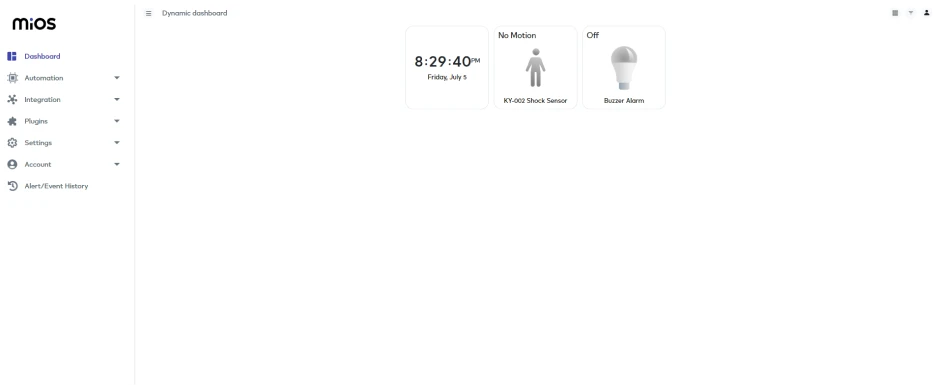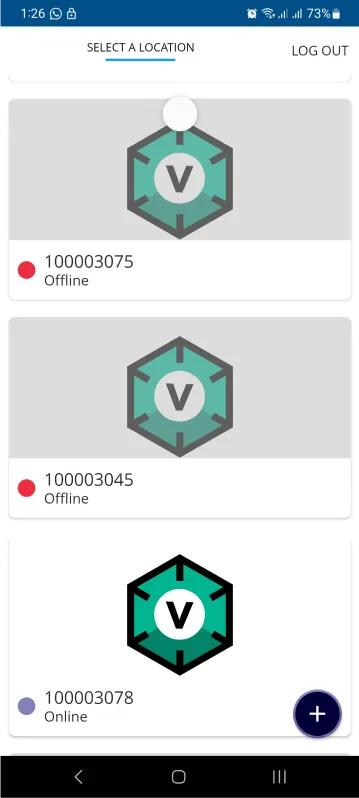
Intelligent response to unexpected events!
Elderly fall detection system using shock sensor and alarm
The EzloPi smart devices provide automation through simple, customizable use with our open-source EzloPi platform, making daily life easier and improving human-machine interactions.
Before moving into this example, it is very important to know about the device registration, provisioning and converting the ESP32 device into an EzloPi device along with knowledge of Web Flasher, MiOS Mobile Application for Android/iOS and the MiOS Web Application.
1. About this example
The following system is designed to monitor falls and provide immediate alerts, ensuring timely assistance for seniors. It utilizes the KY-002 vibration tilt sensor module to detect sudden shocks or falls. When a fall is detected, the MH-FMD buzzer is triggered, generating a loud alarm to notify caregivers or family members. The EzloPi smart device acts as the central hub, processing the sensor's output and activating the alarm system. This system is compact and easy to integrate and ensures enhanced safety and quick response during emergencies, making it an ideal solution for elderly care.
3. Circuit Diagram & Interface
The following components are required for interfacing with the EzloPi device:
- ESP32 as an EzloPi smart device.
- KY-002 Vibration tilt sensor module.
- MH-FMD buzzer
The wiring diagram of ESP32 30 pin is represented as follows:


The following connections are made in order to complete the circuit setup.
From ESP32 to the Shock Sensor Module:
| ESP32 | KY-002 |
| 3V3 | VIN |
| GND | GND |
| D15 | S |
From ESP32 to the Buzzer:
| ESP32 | Buzzer |
| 3V3 | VCC |
| GND | GND |
| D4 | I/O |
4. Interfacing the Vibration Sensor Module with the EzloPi Web Flasher
1. Set up your device/hardware by visiting config.ezlopi.com

- Log in using the credentials which you just set earlier while signing up.

- Now, click on the Connect Device button and a pop-up window will appear.

- Now, select COM Port to which your ESP32 device is connected. In our case, the COM3 port is used.
Click Connect

- If you are new to this and it's your first time configuring, select Create new Device ID. Enter Wifi SSID and Wifi Password.
- In the Device Configuration, tab click on Digital Input.

- A Digital Input window will be opened for inputting the following parameters:
- Set a device name of your choosing. In our case we set it to KY-002 Shock Sensor.
- Set INPUT GPIO pin to 15.
- Set Device Subtype to Vibration Sensor.
- Set Resistor to PULL UP.
- Set Default Value to LOW.
- Then Click Apply Button.
- Again, In the Device Configuration, tab click on Digital Output.

- A Digital Output window will be opened for inputting the following parameters.
- Set a Device name of your choosing. In our case we set it to Buzzer Alarm.
- Set Device Subtype to LED.
- Set OUT GPIO pin to 4.
- Set Resistor to PULL UP.
- Set Default Value to LOW.
- Then Click Apply Button.
- After clicking the apply button you can see a table of your setting in the device configuration tab.
- Press the Flash Device button.
- A window will appear on the bottom right side of the screen displaying “Please press BOOT button while flashing begins.”

- Hold the BOOT button down until the next window appears on the bottom right side of the screen which says “Installation prepared. Please release the boot button now.”

- Release the BOOT button from your ESP32 when this pop-up on the bottom right window appears.

- After some time, a popup will appear saying Device Flashed Successfully! This means that your device has been set up successfully.
5. MiOS Web Dashboard
- After configuring the controller with the EzloPi web flasher, head to ezlogic.mios.com

- Use the same credentials to log in that you used for configuring the controller with the web flasher.

- On the MiOS web dashboard, you will see the tiles of your connected devices as shown above labeled as KY-002 Shock Sensor and Buzzer Alarm. Currently, no shock or vibration is detected by the sensor therefore the shock sensor shows “No Motion” message and buzzer alarm tile also shows the “Off” message.
MeshBots:

- On the left side of the screen under Automation, click on MeshBots.
- On meshbot screen, click on Create new MeshBot button present on the top right corner of the screen.
- After clicking on Create new MeshBot, you will see this now under Automation MeshBot click on EzloPi.

- On the next screen you will see that we can create a name of our choosing, in this case we write it as Test001.

- In the trigger tab you can set the TRIGGER for your device and in the ACTION tab you can set the action to be performed based on the trigger which you have created.

- Set these things in TRIGGER section:
- Set Node Type to Device.
- Set the Node to KY-002 Shock Sensor.
- Set the Capability to Activity.
- Set the value to drop.

- Set these values in the True part of the ACTION section.
- Set Node type to Device.
- Set Controllable to Buzzer Alarm.
- Set Capability to switch.
- Set value to true.

- Set these values in the False part of the ACTION section.
- Set Node type to Device.
- Set Controllable to Buzzer Alarm.
- Set Capability to switch.
- Set value to false.
- After clicking the apply button you can see a table of your setting in the Current configuration tab.

- After clicking the save button you can see this screen on the top right corner of the screen.

- Here you can see your saved MeshBot. Now click on Dashboard.

- Now in the above pic, It shows that the shock sensor detects a shock or high vibrations, the buzzer alarm gets turned ON to alert the family members or caretaker that the elderly person has fallen because of the rules we have set in the meshbot.
6. MiOS App
You can download the MIOS Android app from the Google Play Store and Apple App Store.
- After downloading the app, proceed to install the application and open it.

- Using the MIOS mobile application, create a new Ezlo Cloud account using the sign-up option. If you already have an account, you may proceed to log in.

- After successfully logging in, you will be able to see the number of controllers connected such as a lamp, fan, or any other device in the MiOS app. Tap on any controller of your desired ID:

- You will be able to see the status of your controller whether it is online or offline. Access the device dashboard, and tap the device. The following view of the dashboard will appear:

- Now, on the MiOS web app, you will see the tiles of your connected devices as shown above labeled as KY-002 Shock Sensor and Buzzer Alarm. Currently, no shock or vibration is detected by the sensor therefore the Shock sensor shows “No Motion” message and buzzer alarm tile also shows the “Off” message.

- Now in the above pic, It shows that the shock sensor detects a shock or high vibrations, the buzzer alarm gets turned ON to alert the family members or caretaker that the elderly person has fallen because of the rules we have set in the meshbot.

eZlopie Products A single-channel 5V relay module $00.00

eZlopie Products Momentary switch $00.00

eZlopie Products Level Shifter Module (BSS138) $00.00

eZlopie Products ESP32
$00.00

eZlopie Products AC Lamp and Holder
$00.00












